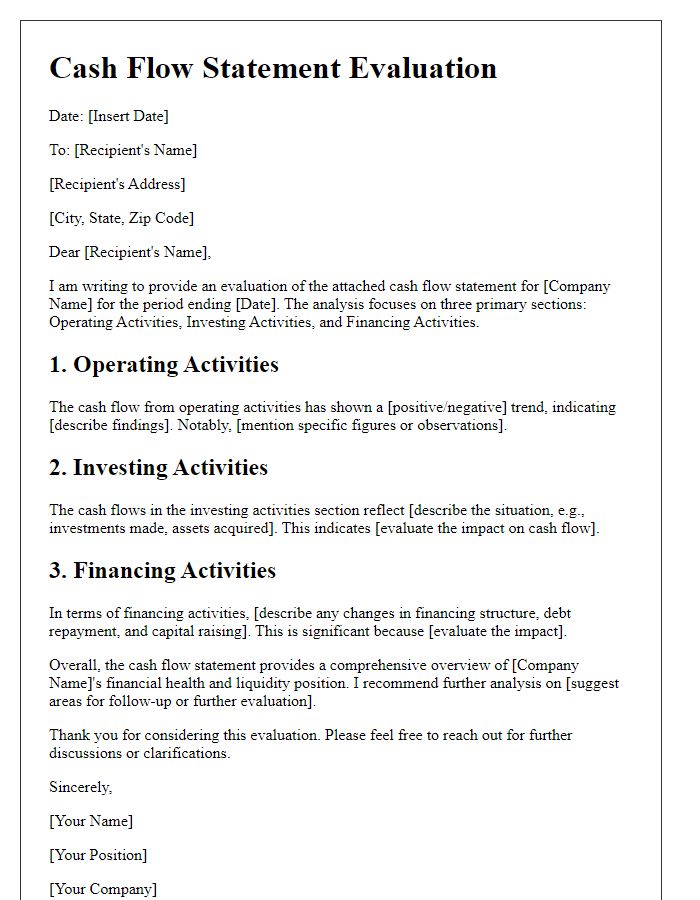Are you looking to enhance your understanding of cash flow statements? In this article, we'll break down the key components that can help you analyze financial health like a pro. By grasping the significance of cash flow from operations, investing, and financing, you'll gain valuable insights into a company's liquidity and performance. So, let's dive in and explore how a solid cash flow statement can empower your financial decision-making!

Introduction to Cash Flow Importance
A cash flow statement is crucial for assessing a company's financial health and operational efficiency. This financial document highlights the inflow and outflow of cash within a specific period, usually quarterly or annually, and helps stakeholders understand the liquidity position of the organization. Adequate cash flow is essential for meeting obligations, such as short-term debts and operational expenses, while also allowing for investments in growth opportunities. Analyzing cash flow trends can reveal vital information about a company's ability to generate cash from its core operations, indicating if it can sustain itself without relying on external financing. Additionally, it offers insights into investment activities, such as purchasing property, plant, and equipment, and financing activities, like issuing debt or equity. Prioritizing cash flow analysis ensures informed decision-making and promotes long-term financial stability.
Overview of Operating Activities
Operating activities are critical components of a cash flow statement, reflecting the cash generated or used in core business operations. This section typically includes receipts from customers for goods sold or services rendered, as well as payments made to suppliers and employees. Common line items include cash received from sales, cash paid for inventory, and cash expenses such as utilities or rent. For example, a retail company might report cash inflows of $500,000 from product sales and cash outflows of $300,000 for inventory purchases during a specific fiscal quarter. Moreover, changes in working capital, such as account receivables or payables, can significantly impact cash flow. Analyzing these activities provides insight into the company's operational efficiency and overall financial health, making it easier for stakeholders to assess liquidity and future growth potential.
Analysis of Investing Activities
Investing activities represent a crucial aspect of cash flow statements, highlighting cash transactions related to the acquisition and disposal of long-term assets, such as property, equipment, and investments. In the fiscal year 2022, Company XYZ invested approximately $1.5 million in new machinery to enhance production efficiency at its manufacturing facility in Springfield, leading to a projected 20% increase in output. Additionally, the company sold a parcel of land for $800,000, realized from a prior investment, contributing positively to overall cash flow. Net cash used in investing activities totaled $700,000, indicating a commitment to future growth despite initial cash outlay. Understanding these investing activities provides insight into the company's long-term strategic direction and capital expenditure decisions, essential for assessing financial health and sustainability.
Insights from Financing Activities
Financing activities in a cash flow statement reveal crucial insights into a company's capital structure and liquidity. For instance, an increase of 20% in long-term debt can indicate a reliance on borrowed funds for expansion projects, while a significant drop in equity financing may suggest a lack of investor confidence or a potential pivot away from public funding. Additionally, substantial dividend payments, such as $5 million in the last quarter, can impact the cash reserves, reflecting a company's commitment to returning value to shareholders while balancing operational cash needs. Cash inflows from new equity issuance, potentially around $3 million, highlight a strategic shift towards bolstering working capital amidst market fluctuations or economic uncertainties. Understanding these financing decisions and their implications provides stakeholders with a clearer picture of financial health and growth strategies.
Conclusion with Cash Flow Strategies
Effective cash flow management is crucial for the financial health of any organization. Implementing sustainable cash flow strategies can enhance liquidity, ensuring that the company meets its obligations while capitalizing on growth opportunities. Maintaining a positive cash flow involves regular monitoring of cash inflows and outflows, optimizing operational efficiencies, and diversifying revenue streams. Establishing a detailed cash flow forecasting model allows businesses to anticipate shortfalls and surplus, enabling timely decision-making. Strategic measures such as renegotiating payment terms with suppliers and enhancing collection efforts from customers can significantly improve cash flow stability. Emphasizing these strategies can lead to improved financial performance and enable the organization to navigate economic fluctuations effectively.













Comments